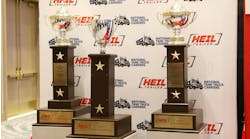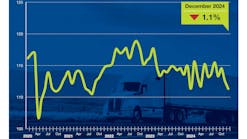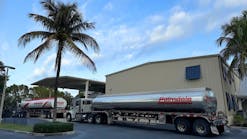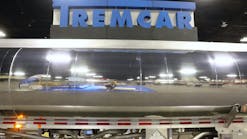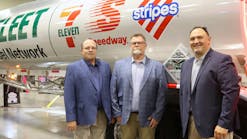To Be most effective, a safety program must be part of the bedrock of the corporate culture. That certainly has been true for Trimac Transportation throughout more than 60 years in business.
The second largest tank truck carrier in North America summarizes its operating philosophy with a succinct slogan: Service with Safety. More specifically, the company's focus on safety meets three critical objectives: It makes Trimac a preferred place to work; it enables the carrier to provide customers with excellent service and deliver the best value for the money; and it helps generate a good shareholder return.
“It's less expensive to operate safely, and it certainly has contributed to Trimac's success over the years,” says Jeff McCaig, Trimac president and chief executive officer. “Safety is the only thing we can do that truly makes us stand out from the competition.”
The obsession with safety brought more than just a good return on investment in 2007. Trimac Transportation — which has headquarters in Houston, Texas, and Calgary, Alberta, Canada — earned its second Outstanding Performance Trophy in the 2007 National Tank Truck Carriers Safety Contest. The tank truck carrier claimed its first Outstanding Performance Trophy in 2002.
Trimac earned its newest Out-standing Performance Trophy with a frequency of 0.386 accidents per million miles in 2007. The carrier also received the Grand Award in the “Over 100 million miles class” of the Personnel Safety Contest, and it took home a 13-year safety improvement award.
Len Comtois, safety director for Trimac Transportation Canada, and Neil Voorhees, safety director for Trimac Transportation US, were named co-safety directors of the year by NTTC. This was the first time NTTC had honored co-safety directors.
Safety first
“We have always prided ourselves on a safety-first focus,” McCaig says. “The NTTC awards are recognition that we are achieving that objective. The award certainly reinforces our core values. We believe the Outstanding Performance Trophy helps demonstrate to our customers that they have a premier partner in the transport of their bulk products. The NTTC safety competition raises the bar for safety across the tank truck industry.
“The NTTC award means a lot to all of us at Trimac. We're definitely going to celebrate this achievement throughout our organization.”
Tom Connard, president and chief operating officer of Trimac Transportation USA, says the trophy validates all of the hard work on safety by Trimac employees. “This award spotlights Trimac as a safe company and shows that our safety focus is the right strategy,” he says. “Perhaps most importantly, the NTTC safety contest recognized Trimac for 13 years of safety improvement. That shows we have built a consistent program.”
Comtois said winning the 2007 Outstanding Performance Trophy came as a pleasant surprise for the company. “While we didn't expect to win the trophy, it shows that we have built a very effective safety program with some innovative strategies for driver management and accident and injury reduction,” he says. “This award certainly recognizes the commitment to safety by all Trimac employees.”
The goal at Trimac is to be the best of the best in safety, and the NTTC Outstanding Performance Trophy validated that effort, according to Voorhees. The carrier plans to use the award to reinforce the value of the safety program with all Trimac employees.
“We believe it is important to celebrate this accomplishment with all of our drivers, mechanics, wash rack workers, and other employees,” he says. “We want them to know that their support was critical in the success we've achieved with our safety program. Other key factors were the systems, such as predictive modeling, that we've implemented over the past few years.”
Connard says the basic assumption at Trimac is that everyone values safety. “We believe nobody wants to work for an unsafe company,” he says. “Customers don't want to work with an unsafe trucking company, and insurance companies don't want to be involved in any way with an unsafe operation.
“We've put together the safest operation we can, and the program is an ongoing effort. We shamelessly steal the best safety ideas we find at other companies.”
Trimac starts with good people and good processes as the foundation of its safety program. Additionally, the carrier uses the most stringent Canadian and US safety regulations as the basis for a unified safety program that spans both countries. Finally, management constantly raises the safety bar.
“High goals aren't always achievable, but they are a starting point,” Connard says. “We also changed some of the safety-related terminology that we use. For instance, we don't use the term “accident” anymore. When a vehicle runs into something, it's a crash. So, we call it a crash, and it sounds more serious. It's amazing what that has done for the mindset of everyone at Trimac.”
Trimac's safety program demands a total commitment from managers at all levels. In fact, safety plays a critical role in the selection process for top executives as well as other managers throughout the company.
“We assess the safety commitment of all candidates for top-level positions at Trimac,” says Barry Davy, Trimac senior vice-president. “We want to make sure that they will fit with our culture. Safety commitment helps us identify the ideal branch manager. Every manager is part of the Trimac safety program, and safety commitment is a factor in promotions at all levels. Safety leads off every executive meeting.
“There is no room for compromise on the issue of safety in our corporate culture. Our goals are zero crashes and zero incidents. We constantly measure our processes and results using targets based on the previous year's performance.”
Branch focus
Possibly no part of the Trimac system gets more of the safety spotlight than the branches. Connard says the branches are a priority because that's where revenues and profits are generated. It's also the part of the company that has the most influence on drivers.
Branch management is the toughest job in this company,” Connard says. “We measure three key factors in branch performance — safety, employee retention, and financials — and we do it in that order. We have a model branch program, and we perform annual branch assessments.”
Predictive modeling is used to measure management performance at each branch. The predictive modeling and ranking system also is used for Trimac's approximately 3,000 drivers — both company and owner-operators. It is a critical part of ongoing performance reviews. Drivers are ranked as Level I (strong in all categories), Level II (needs improvement), and Level III (needs immediate attention).
“We review Level II and Level III drivers every month, and we develop action plans to address their deficiencies,” Voorhees says. “We do our best to encourage improvement but there are limits. We want to retain the best drivers and get the bad actors out of the tank truck industry.”
Driver evaluation
The driver selection process includes a Mega-Safe test that analyzes an individual's safety focus. Applicants must score at least 10 points in the safety section of the test and must have an overall score of 70. Besides safety focus, the test evaluates job stability and behaviorial attributes. It identifies individuals who are team players.
“Using Mega Safe has enabled Trimac to become more selective in choosing drivers,” Voorhees says. “It's much more difficult today for our branch managers to hire drivers, but we are getting better people. We could use more drivers right now, but we're not going to jeopardize safety just to fill a truck.”
Other Trimac driver qualifications include at least eight years' driving experience (not all of which must be in a truck), at least two years of tractor-trailer operation, and a driving record with no major preventable accidents, no suspensions in the past three years, and no more than two highway violation convictions.
Those who make it through the selection process are categorized initially as Level II or Level III drivers, based on prior experience and work history. “Most newly selected drivers move to Level I within 90 days to six months,” Voorhees says.
Learning centers
This is just the beginning of the process that makes a newly selected driver part of the Trimac team. Within 30 days of signing on with the tank truck carrier, drivers are sent to one of two Trimac Learning Centers for four days of corporate orientation and training. US drivers go to the learning center in Houston, and Canadian drivers are sent to the Sherwood Park, Alberta, facility.
“In my opinion, the two most important aspects of the Trimac safety program are predictive modeling and the Trimac Learning Center (TLC),” Voorhees says. “It's important to have centralized training that treats all drivers the same way. We want consistent training, and we want all of our drivers to know that they are working for an elite organization.”
Newly selected drivers aren't the only ones attending the program at the Trimac Learning Centers. Branch managers and dispatchers are being sent through the program. A special two-day class for all of the US-based Trimac driver instructors was held at the Houston center in June.
“We're sending the branch managers and dispatchers through the program a few at a time,” Voorhees says. “It will take about two years to complete that project. We did the special driver instructor program because we want to make sure we have the right people in those positions. We may use the training centers for driver remedial training when called for by predictive modeling reviews.”
With Trimac's current selection requirements, experienced drivers are the current focus for the TLC training program. As the driver shortage worsens over the next few years, that could change.
“We want to build a driver program that is so good that people are lined up at the door asking for a job,” Voorhees says. “This includes developing strategies to attract people who are new to trucking. As an industry, we need the ability to target young people who have just graduated from high school. By age 21, a young driver should be allowed to work with hazardous materials.
“If high school graduates can join the US military at 17, why can't they drive a truck? We need to work more with local schools to point out the opportunities in trucking. We need to speak with high school students of all ages and recruit like the military. We need to show teenagers the amount of technology that goes into today's heavy-duty truck.
“Certainly, younger drivers would need a lengthy training process, and companies like Trimac would need to offer a career path with more than just driving. We all have to invest enough to ensure that we have good drivers for the future. At Trimac, we've already begun to make those investments in programs like our learning centers.”
The Houston facility was the second of the Trimac Learning Centers, and the program was launched in July 2007. The first class was held during the week of October 2. To date, more than 315 of the 1800 US drivers have gone through the program in Houston, and a similar number have completed training at the Sherwood Park location.
Four-day program
Thomas Shepherd is manager of the Houston TLC. He developed the curriculum working with a team that included Joe Shows, Winnie Vaughn, Dale Kyle, and Jeremy Harris. While a mix of videos and hands-on instruction is used, the program has been carefully structured to put the focus on the Trimac driver and his role in the company.
“Our curriculum is designed to meet the needs of drivers with a wide range of trucking experience and skills,” Shepherd says. “Further, our system works best with a maximum class size of 12 students. We want all of our students to learn a uniform approach to the job at Trimac. Our students get a big dose of Trimac culture throughout the four-day orientation. We want students to know that they are working for a company that cares, and we want the program to be one of our driver retention tools.”
Each class starts at 8 am on Tuesday and begins with a review of Trimac policies and procedures. Department of Transportation requirements are covered. The policy and regulatory instruction continues through Wednesday. Rollover prevention is a key discussion point during the first two days.
“We're working hard to boost rollover awareness with all of our drivers,” Voorhees says. “It's part of our TLC program, and we also use the J J Keller rollover awareness program as part of our on-going safety training at the branches. The training is working, and we've seen a reduction in rollovers at this company, but we've still got work to do.”
Much of the Thursday program is hands-on and focuses on operation of pumps, compressors, and cryogenic trailer systems. HM-126 training is covered.
Training wraps up on Friday with the Decision Driving program used by Trimac. The final stage is commentary driving in which Trimac driver instructors spend 15 to 20 minutes on the road reviewing the driving habits of each student.
Safety gets plenty of attention throughout the training. Instructors point out that the Trimac system is designed to capture a wide range of data on driver performance, including minor incidents and customer non-conformances. Daily performance is documented in detail.
“We've made a sizable investment in our safety management system, and it is paying off,” Voorhees says. “This system makes it possible to spot the drivers who are pushing the envelope. We are weeding out the riskiest, costliest drivers. The system also helps us document the safety savings.”
Comtois adds that the basic objectives of the system are two-fold: protect the public and ensure that each and every Trimac driver makes it home safely at the end of every trip.
Vehicle safety
The carrier also has made sizable investments in safety-related vehicle technology. “We're not trying to be the industry leader in the technology arena,” Comtois says. “We just want to find products and services that work in our operation.”
For more than 10 years, Trimac has been running satellite tracking and communication systems in its tractors. The Qualcomm system is used in US-based tractors, and the WebTech product is used in Canadian tractors.
Comtois explains that the WebTech system will facilitate a shift to the automated driver logs that are now being implemented in Canada. “We will have an enhanced ability to monitor hours of service,” he says. “We'll be able to take quick action with problem drivers.”
Voorhees adds that the Qualcomm and WebTech systems have become the basic communication tool for the Trimac fleet. Cell phone use is now prohibited in Trimac tractors that are underway unless the mobile phone is a hands-free unit.
Turning to rollover prevention, the newest Freightliner Columbia and Kenworth T800 tractors in the fleet were specified with roll stability. The Freightliners have the MeritorWABCO system, and the Kenworths are using the Bendix ESP product.
New tractors also are being outfitted with Bendix air disc brakes. “In addition to improved braking, we expect brake pad life to equal tractor life on an 80,000-lb rig,” says Bill Januszewski, Trimac director of purchasing and equipment technical services. “Disc brake pads should give us two to three times the life we get out of drum brakes.”
Tractors in Trimac's cryogenic products fleet are being specified with Vorad collision avoidance and Iteris lane departure warning systems. “Based on what we've seen so far, we could envision putting the Vorad system on more tractors in the future,” Januszewski says.
From an environmental standpoint, several newer tractors in the fleet were fitted with Kenworth and Freightliner battery-powered auxiliary power systems that eliminate the need to leave the engine idling while the driver is resting in the sleeper. The systems power the truck's heating, ventilating, and air-conditioning.
In addition to the on-board power systems that are being tested, the carrier has an IdleAire contract for a basic service package. IdleAire is available at certain truck stops, and the contract covers air-conditioning, heat, and basic television and computer connections. All of the connections are contained in a removable unit that mounts in the door window of the tractor.
Safety systems on the tank trailers include fall protection as standard equipment. Most of the chemical tankers in the 6,000-trailer fleet were built by Polar Tank Trailer Inc. Typical capacity is 7200 gallons for the tandem-axle chemical tankers used in the US market.
Pop-up guardrail
A majority of the chemical trailers have a pop-up guardrail system that Trimac managers helped design. The carrier has used that system since 1994. More recently, Trimac has begun testing the TRAM fall protection system from Standfast USA. Janaszewski says the initial results for the Standfast system have been very promising.
The newest tank trailers in the fleet were specified with Intraax air suspensions. Some of these trailers also are being ordered with the Bendix TABS-6 antilock braking and roll stability.
“Looking at all of the aspects of the safety program at this point, we really believe that we have a solid framework in place,” Voorhees says. “The NTTC Outstanding Performance Trophy proves that we are on the right track. If we stay the course, we'll have an unbeatable safety record within two to three years. The sky's the limit on future safety improvement at Trimac.”
